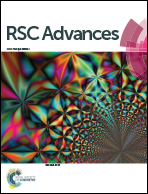Enhanced visible light photocatalytic activity of polyaniline–crystalline TiO2–halloysite composite nanotubes by tuning the acid dopant in the preparation†
Abstract
Tubular halloysite minerals are used as support for the fabrication of one-dimensional polyaniline–crystalline TiO2–halloysite composite nanotubes in the presence of different acid dopant at low temperature. By simply adjusting the acidity of the reaction system, PANI–crystalline TiO2–HA composite nanotubes composed of anatase, a mixed phase TiO2 and different PANI redox state are obtained. The acidity of reaction system is tuned by HNO3, HCl, H2SO4 and H3PO4, respectively. The traditional thermal treatment for crystalline transformation is not required, thus intact halloysite structure can be guaranteed. The XRD and UV-vis results show that the surface polyaniline sensitization has no effect on the crystalline structure of halloysite and the light response of TiO2 is extended to visible-light regions, respectively. The visible light photocatalytic activity of polyaniline–crystalline TiO2–halloysite with HCl tuning the acidity (pH 0.5) and 1% volume ratio of aniline to titanium isopropoxide in the preparation (P-TH/0.5/1%-HCl) is superior to those of samples with H2SO4, HNO3 and H3PO4 tuning the acidity in the preparation at the same acidity and volume ratio of aniline to titanium isopropoxide. Such superior photocatalytic activity of P-TH/0.5/1%-HCl is mainly due to the enhanced visible light adsorption and electrical conductivity. Furthermore, redoping P-TH/0.5/1%-HCl with H2SO4 and H3PO4 demonstrates its photocatalytic activity decreases, indicating the acid dopants in the preparation and redoping process play a important role to the photocatalytic activity of the polyaniline–crystalline TiO2–halloysite composite nanotubes. Moreover, the supported catalyst allows them to be easily separated from the solution.


 Please wait while we load your content...
Please wait while we load your content...